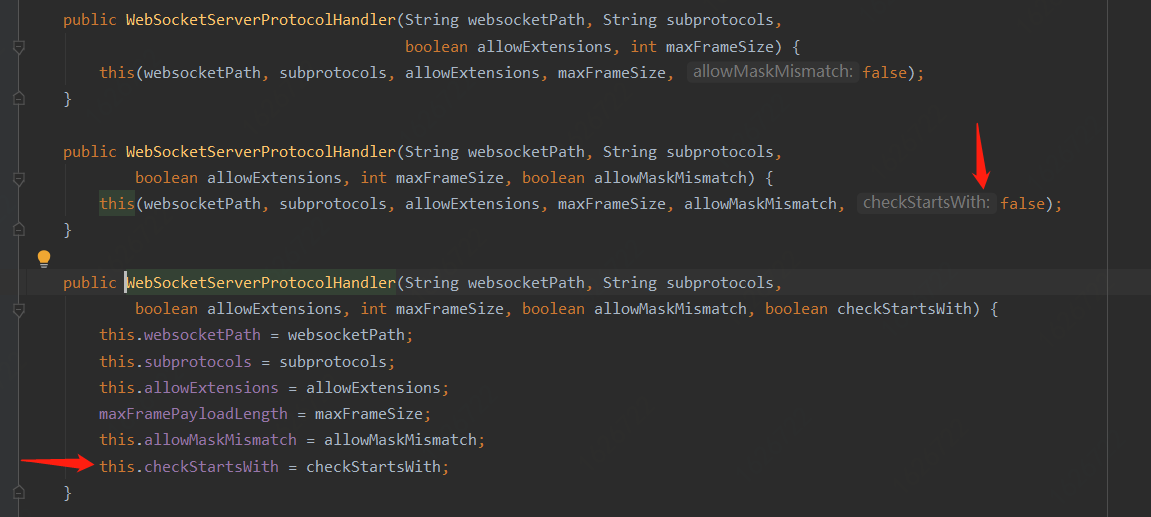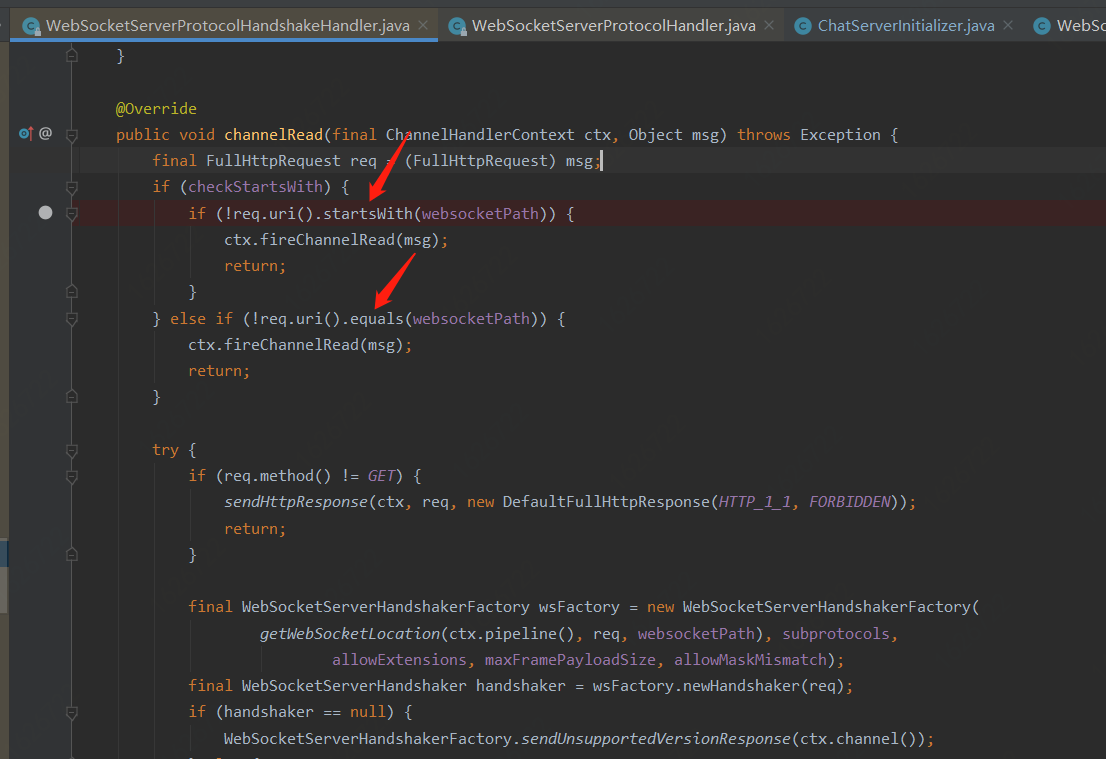一.URI带参数方式:
1、问题:
Netty对WebSocket提供了很好的支持,在pipeline里添加一个WebSocketServerProtocolHandler就可以方便的暴露一个ws接口出去。但是,开发中却遇到一点小问题,需要在ws的URI带上参数queryString(如:/im/ws?w=221100234&t=99),然而这样会导致ws连接无法建立,浏览器报错:Connection closed before receiving a handshake response。
2、解决:
因为全安问题,ws是不推荐通过queryString携带信息的,所以Netty里WebSocketServerProtocolHandler默认的构造器是要求对连接建立时传入的URI与程序指定的路径完全匹配。
 checkStartsWith即是控制根据startsWith来做URI匹配,所以改用重载的构造器即可解决问题(注意queryString上不要携带敏感信息)。
checkStartsWith即是控制根据startsWith来做URI匹配,所以改用重载的构造器即可解决问题(注意queryString上不要携带敏感信息)。
 checkStartsWith使用的地方如下图中WebSocketServerProtocolHandshakeHandler类:
checkStartsWith使用的地方如下图中WebSocketServerProtocolHandshakeHandler类:

示例代码
netty服务端(简单鉴权):
import io.netty.bootstrap.ServerBootstrap;
import io.netty.channel.*;
import io.netty.channel.nio.NioEventLoopGroup;
import io.netty.channel.socket.SocketChannel;
import io.netty.channel.socket.nio.NioServerSocketChannel;
import io.netty.handler.codec.http.FullHttpRequest;
import io.netty.handler.codec.http.HttpObjectAggregator;
import io.netty.handler.codec.http.HttpServerCodec;
import io.netty.handler.codec.http.websocketx.TextWebSocketFrame;
import io.netty.handler.codec.http.websocketx.WebSocketServerProtocolHandler;
import io.netty.handler.logging.LogLevel;
import io.netty.handler.logging.LoggingHandler;
import io.netty.handler.stream.ChunkedWriteHandler;
import java.time.LocalDateTime;
public class NettyTest {
public static void main(String[] args) {
NioEventLoopGroup boos = new NioEventLoopGroup();
NioEventLoopGroup worker = new NioEventLoopGroup();
try {
ServerBootstrap bootstrap = new ServerBootstrap();
bootstrap.group(boos, worker).channel(NioServerSocketChannel.class).handler(new LoggingHandler(LogLevel.INFO)).childHandler(new ChannelInitializer<SocketChannel>() {
@Override
protected void initChannel(SocketChannel ch) throws Exception {
ChannelPipeline pipeline = ch.pipeline();
pipeline.addLast(new HttpServerCodec());
pipeline.addLast(new ChunkedWriteHandler());
pipeline.addLast(new HttpObjectAggregator(8192));
pipeline.addLast(new MyHttpHandler());
pipeline.addLast(new IdleStateHandler(10, 0, 0));
//此处构造参数为false,判断uri前部分符合即可,否则需要完全一致
pipeline.addLast(new WebSocketServerProtocolHandler("/hello", false));
//自定义handler
pipeline.addLast(new MyWebSocketHandler());
}
});
ChannelFuture sync = bootstrap.bind(8888).sync();
sync.channel().closeFuture().sync();
} catch (Exception e) {
e.printStackTrace();
} finally {
boos.shutdownGracefully();
worker.shutdownGracefully();
}
}
static class MyHttpHandler extends SimpleChannelInboundHandler<FullHttpRequest> {
@Override
protected void channelRead0(ChannelHandlerContext ctx, FullHttpRequest msg) throws Exception {
Map<CharSequence, CharSequence> queryMap = UrlBuilder.ofHttp(msg.uri()).getQuery().getQueryMap();
CharSequence token = queryMap.get("token");
if (token == null) {
token = msg.headers().get("token");
}
//提前结束传递,关闭连接
//if (token == null || !token.equals("1")) {
// ctx.writeAndFlush("token错误").addListener(ChannelFutureListener.CLOSE);
// return;
//}
ctx.channel().attr(AttributeKey.valueOf("token")).setIfAbsent(token.toString());
ctx.fireChannelRead(msg.retain());
}
}
static class MyWebSocketHandler extends SimpleChannelInboundHandler<TextWebSocketFrame> {
@Override
protected void channelRead0(ChannelHandlerContext ctx, TextWebSocketFrame msg) throws Exception {
System.out.println("服务器收到消息:" + msg.text());
String respMsg = "服务器时间:" + LocalDateTime.now() + ";" + msg.text();
ctx.writeAndFlush(new TextWebSocketFrame(respMsg));
}
//客户端链接触发
@Override
public void handlerAdded(ChannelHandlerContext ctx) throws Exception {
//asLongText 唯一,asShortText 非唯一
System.out.println("handlerAdded asLongText" + ctx.channel().id().asLongText());
System.out.println("handlerAdded asShortText" + ctx.channel().id().asShortText());
//super.handlerAdded(ctx);
}
//客户端退出触发
@Override
public void handlerRemoved(ChannelHandlerContext ctx) throws Exception {
//asLongText 唯一,asShortText 非唯一
System.out.println("handlerRemoved asLongText" + ctx.channel().id().asLongText());
System.out.println("handlerRemoved asShortText" + ctx.channel().id().asShortText());
//super.handlerRemoved(ctx);
}
@Override
public void exceptionCaught(ChannelHandlerContext ctx, Throwable cause) throws Exception {
System.out.println("异常发生" + cause.getMessage());
//super.exceptionCaught(ctx, cause);
ctx.close();
}
//客户端心跳监测
@Override
public void userEventTriggered(ChannelHandlerContext ctx, Object obj) throws Exception {
//协议握手成功完成,进行验签
if (obj instanceof WebSocketServerProtocolHandler.HandshakeComplete) {
AttributeKey<String> attributeKey = AttributeKey.valueOf("token");
//从通道中获取用户token
String token = ctx.channel().attr(attributeKey).get();
//校验token逻辑
if (!token.equals("1")) {
//如果token校验不通过,发送连接关闭的消息给客户端,设置自定义code和msg用来区分下服务器是因为token不对才导致关闭
ctx.writeAndFlush(new CloseWebSocketFrame()).addListener(ChannelFutureListener.CLOSE);
}
}
if (obj instanceof IdleStateEvent) {
IdleStateEvent event = (IdleStateEvent) obj;
if (event.state() == IdleState.READER_IDLE) {
System.out.println("客户端读超时");
ctx.writeAndFlush(new TextWebSocketFrame("读超时")).addListener(ChannelFutureListener.CLOSE);
} else if (event.state() == IdleState.WRITER_IDLE) {
System.out.println("客户端写超时");
} else if (event.state() == IdleState.ALL_IDLE) {
System.out.println("客户端所有操作超时");
}
}
}
}
}
netty客户端:
package websocket;
import io.netty.bootstrap.Bootstrap;
import io.netty.buffer.Unpooled;
import io.netty.channel.*;
import io.netty.channel.nio.NioEventLoopGroup;
import io.netty.channel.socket.SocketChannel;
import io.netty.channel.socket.nio.NioSocketChannel;
import io.netty.handler.codec.http.DefaultHttpHeaders;
import io.netty.handler.codec.http.FullHttpResponse;
import io.netty.handler.codec.http.HttpClientCodec;
import io.netty.handler.codec.http.HttpObjectAggregator;
import io.netty.handler.codec.http.websocketx.*;
import io.netty.handler.codec.http.websocketx.extensions.compression.WebSocketClientCompressionHandler;
import io.netty.util.CharsetUtil;
import java.io.BufferedReader;
import java.io.IOException;
import java.io.InputStreamReader;
import java.net.URI;
import java.net.URISyntaxException;
public class NettyWebsocketClientTest {
public static void main(String[] args) throws InterruptedException {
try {
start();
} catch (URISyntaxException e) {
e.printStackTrace();
}
}
public static void start() throws URISyntaxException {
URI uri = new URI("ws://127.0.0.1/hello?token=2");
DefaultHttpHeaders httpHeaders = new DefaultHttpHeaders();
httpHeaders.add("token", "2");
TestSocketClientHandler handler =
new TestSocketClientHandler(
WebSocketClientHandshakerFactory.newHandshaker(
uri, WebSocketVersion.V13, null, true, httpHeaders));
EventLoopGroup group = new NioEventLoopGroup();
try {
Bootstrap b = new Bootstrap();
b.group(group)
.channel(NioSocketChannel.class)
.handler(new ChannelInitializer<SocketChannel>() {
@Override
protected void initChannel(SocketChannel ch) {
ChannelPipeline p = ch.pipeline();
p.addLast(new HttpClientCodec());
p.addLast(new HttpObjectAggregator(8192));
p.addLast(WebSocketClientCompressionHandler.INSTANCE);
p.addLast(handler);
}
});
Channel ch = b.connect(uri.getHost(), 8888).sync().channel();
handler.handshakeFuture().sync();
BufferedReader console = new BufferedReader(new InputStreamReader(System.in));
while (true && ch.isOpen()) {
System.out.println();
String msg = console.readLine();
if (msg == null) {
break;
} else if ("再见".equalsIgnoreCase(msg)) {
ch.writeAndFlush(new CloseWebSocketFrame());
ch.closeFuture().sync();
break;
} else if ("ping".equalsIgnoreCase(msg)) {
WebSocketFrame frame = new PingWebSocketFrame(Unpooled.wrappedBuffer(new byte[]{8, 1, 8, 1}));
ch.writeAndFlush(frame);
} else {
WebSocketFrame frame = new TextWebSocketFrame(msg);
ch.writeAndFlush(frame);
}
}
} catch (IOException e) {
e.printStackTrace();
} catch (InterruptedException e) {
e.printStackTrace();
} finally {
group.shutdownGracefully();
}
}
public static class TestSocketClientHandler extends SimpleChannelInboundHandler<Object> {
private final WebSocketClientHandshaker handshaker;
private ChannelPromise handshakeFuture;
public TestSocketClientHandler(WebSocketClientHandshaker handshaker) {
this.handshaker = handshaker;
}
public ChannelFuture handshakeFuture() {
return handshakeFuture;
}
@Override
public void handlerAdded(ChannelHandlerContext ctx) {
handshakeFuture = ctx.newPromise();
}
@Override
public void channelActive(ChannelHandlerContext ctx) {
handshaker.handshake(ctx.channel());
}
@Override
public void channelInactive(ChannelHandlerContext ctx) {
System.out.println("channelInactive!");
}
@Override
public void channelRead0(ChannelHandlerContext ctx, Object msg) throws Exception {
Channel ch = ctx.channel();
if (!handshaker.isHandshakeComplete()) {
try {
handshaker.finishHandshake(ch, (FullHttpResponse) msg);
System.out.println("websocket Handshake 完成!");
handshakeFuture.setSuccess();
} catch (WebSocketHandshakeException e) {
System.out.println("websocket连接失败!");
handshakeFuture.setFailure(e);
}
return;
}
if (msg instanceof FullHttpResponse) {
FullHttpResponse response = (FullHttpResponse) msg;
throw new IllegalStateException(
"Unexpected FullHttpResponse (getStatus=" + response.status() +
", content=" + response.content().toString(CharsetUtil.UTF_8) + ')');
}
WebSocketFrame frame = (WebSocketFrame) msg;
if (frame instanceof TextWebSocketFrame) {
TextWebSocketFrame textFrame = (TextWebSocketFrame) frame;
System.out.println("接收到TXT消息: " + textFrame.text());
} else if (frame instanceof PongWebSocketFrame) {
System.out.println("接收到pong消息");
} else if (frame instanceof CloseWebSocketFrame) {
System.out.println("接收到closing消息");
ch.close();
}
}
@Override
public void exceptionCaught(ChannelHandlerContext ctx, Throwable cause) {
// 异常处理
System.out.println("出现异常");
if (!handshakeFuture.isDone()) {
handshakeFuture.setFailure(cause);
}
ctx.close();
}
}
}
html:
<!DOCTYPE html>
<html lang="en">
<head>
<meta charset="UTF-8">
<title>hello</title>
</head>
<script>
var socket;
if(window.WebSocket){
socket = new WebSocket("ws://localhost:8888/hello?token=1");
//可以收到服务器端发送的消息
socket.onmessage = function(p1){
var rt = document.getElementById('responseTxt');
rt.value = rt.value + "\n" + p1.data+"\n";
};
//链接成功
socket.onopen = function(p1){
var rt = document.getElementById('responseTxt');
rt.value = "链接开启\n";
};
//链接关闭
socket.onclose = function(p1){
var rt = document.getElementById('responseTxt');
rt.value = rt.value+"链接关闭了\n";
};
}else{
alert("当前浏览器不支持websocket");
}
//发送消息
function send(){
var msg = document.getElementById("msg").value;
if(!window.socket){
return;
}
if(socket.readyState == WebSocket.OPEN){
socket.send(msg);
document.getElementById("msg").value = '';
}else{
alert("链接没有打开");
}
}
</script>
<body>
<form onsubmit="return false" >
<textarea id = "msg" name = "message" style="height: 300px;width: 300px"></textarea>
<input type="button" value="发送消息" onclick="send()" >
<textarea id = "responseTxt" style="height: 300px;width: 300px"></textarea>
<input type="button" value="清空"
onclick="document.getElementById('responseTxt').value = ''" >
</form>
</body>
</html>
二.使用websocket私有协议方式 (Sec_WebSocket-Protocol)
三.使用netty作为反向代理配置
map $http_upgrade $connection_upgrade {
default upgrade;
'' close;
}
server {
listen 80;
location /hello {
proxy_pass http://127.0.0.1:8888;
proxy_read_timeout 300s;
proxy_send_timeout 300s;
proxy_set_header Host $host;
proxy_set_header X-Real-IP $remote_addr;
proxy_set_header X-Forwarded-For $proxy_add_x_forwarded_for;
proxy_http_version 1.1;
proxy_set_header Upgrade $http_upgrade;
proxy_set_header Connection $connection_upgrade;
}
}
本文由 GY 创作,采用 知识共享署名4.0 国际许可协议进行许可
本站文章除注明转载/出处外,均为本站原创或翻译,转载前请务必署名
最后编辑时间为:
2022/08/02 13:58
